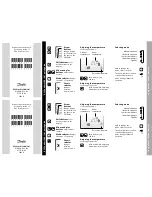
Chapter 7 Earthing and Shielding
GFK-2958E
RSTi-EP User Manual
338
7.4
Shielding of Cables
To prevent the coupling of interference voltages and the decoupling of interference fields in cables,
only shielded cables made from well-conducting material (copper or aluminium) with braided
shielding and a coverage of at least 80 % should be used in the design of a cable shield.
Only when a cable shield is connected to the local reference potential on both sides is it possible to
achieve optimal shielding against electric and magnetic fields. Exceptions are possible, for example,
with high-impedance, symmetrical or analogue signal cables. If a shield is attached on only one side,
this merely achieves an isolation against electric fields.
Caution
Requirements for effective shielding design:
•
The shield connection to the shield bus should be low impedance
•
The shield must be connected directly at its entrance into the system
•
Keep cable ends as short as possible
•
Do not use cable shields for equipotential bonding
When connecting a data cable using a sub-D connector, the connection must be made through the
connector's shield collar and never through pin 1.
The data cable's shield must be attached to the shield bus with the insulation stripped away. The
shield is to be connected and attached with clamping brackets or similar metal fixing devices. The
shield bus must be connected to the reference potential surface through a low impedance [e.g.
fastening point with a separation of 10 to 20 cm
(3.94” x 7.87”
)]. The brackets must surround and
make contact with a large part of the shield.
Isolation of the cable shield should be avoided. Instead, it should be routed into the system (for
example, the switch cabinet) up to the interface connection.
Attention
When shielding field-bus cables, the installation guidelines for the
respective field buses must be observed. (Refer the websites of the field bus
organizations.)
Caution
If it is only possible to have a one-sided shield connection for reasons specific
to the circuit or equipment, the second side of the cable shield can be routed to
the local reference potential via a capacitor (with short connections). To
prevent disruptive discharges when interference pulses occur, a varistor or a
resistor can also be wired in parallel to the capacitor.
As an alternative, a doubled version (galvanically isolated) can be used,
whereby the inner shield is connected on one side and the outside shield is
connected on both sides.
Содержание GFK-2958E
Страница 1: ...RSTi EP User Manual GFK 2958E November 2017 ...
Страница 23: ...Chapter 1 Introduction GFK 2958E RSTi EP User Manual 19 Notes ...
Страница 56: ...Chapter 3 Configuration GFK 2958E RSTi EP User Manual 52 Notes ...
Страница 166: ...Chapter 5 Detailed Descriptions of I O Modules GFK 2958E RSTi EP User Manual 162 EP 5111 Block Diagram EP 5111 ...
Страница 183: ...Chapter 5 Detailed Descriptions of I O Modules GFK 2958E RSTi EP User Manual 179 EP 5111 ...
Страница 184: ...Chapter 5 Detailed Descriptions of I O Modules GFK 2958E RSTi EP User Manual 180 EP 5111 ...
Страница 211: ...Chapter 5 Detailed Descriptions of I O Modules GFK 2958E RSTi EP User Manual 207 Frequency Counter EP 5212 ...
Страница 316: ...Chapter 5 Detailed Descriptions of I O Modules GFK 2958E RSTi EP User Manual 312 Notes ...
Страница 330: ...Chapter 6 Installation GFK 2958E RSTi EP User Manual 326 Notes ...
Страница 344: ...Chapter 7 Earthing and Shielding GFK 2958E RSTi EP User Manual 340 ...
Страница 345: ...Chapter 7 Earthing and Shielding GFK 2958E RSTi EP User Manual 341 Notes ...
Страница 385: ...Chapter 8 Web Server GFK 2958E RSTi EP User Manual 381 Notes ...
Страница 401: ...Chapter 11 Disassembly and Disposal GFK 2958E RSTi EP User Manual 397 Notes ...
Страница 413: ...Chapter 12 LED Indicators and Troubleshooting GFK 2958E RSTi EP User Manual 409 Notes ...
Страница 416: ...Chapter 14Accessories and Replacement Parts GFK 2958E RSTi EP User Manual 412 Notes ...
















































